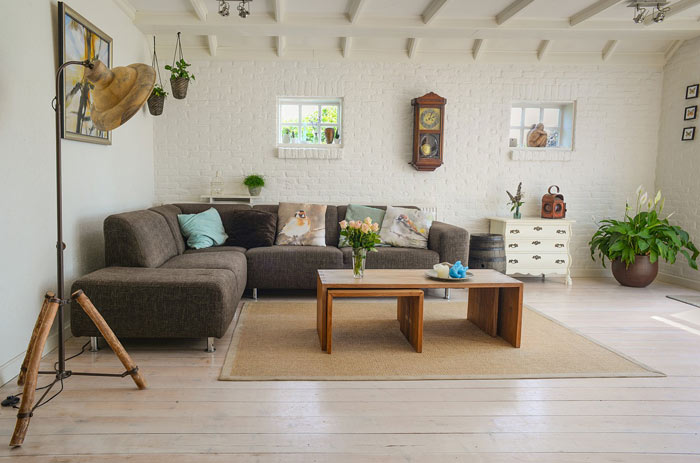The ambiance of your living room can have a massive impact on your guests’ first impressions, as well as how you feel when you’re relaxing at home. But the ambiance is subjective, so it can’t be fixed as simply as buying a new end table or hanging up a piece of art. Fortunately, there are some small and simple touches that can take the atmosphere of any living room to the next level, and ensure you and your guests get the right feeling upon entry.

Little Ways to Improve Living Room Ambience
Try these touches to transform your living room to be the welcoming environment you want:
Install a fireplace or wood stove. Getting a fireplace or a natural wood stove can instantly make your living room warmer, more comfortable, and more charming. It may cost a few hundred to a few thousand dollars to get one installed, depending on your current setup, but it can transform your living space to be much more welcoming to guests and family members alike. You’ll be especially grateful you have it during winter months.
Experiment with speaker placement options. The design of your living room can only take you so far. You’ll also need to consider your music choices to create the right atmosphere. However, the quality and placement of your speakers can make a massive difference in how music is perceived. Aim to keep your speakers hidden, but placed in a way that can fill the room with warm, high-quality sound.
Make use of flexible lighting. Similarly, your lighting can make a major impact in how your furniture, décor, and the room overall are perceived. For different events, moods, and situations, you’ll need different types of lighting; for example, a subtle background light works perfectly for watching movies, but you’ll need bright spot lighting to read or work on projects. Install lighting options that give you more flexibility to change between these settings.
Get clever with mirrors. A well-placed mirror can make a small room look bigger, or highlight a piece of art on an opposing wall. Take the time to choose an appropriately sized, well-designed mirror (or several), and use them to enhance what you already have.
Be minimal, but make your accents count. In general, minimalism works better for living rooms than cluttered pieces of décor. Keep the space open, with plenty of room to move around in. That said, pay close attention to your accent pieces, and make them count, with bold colors or unique designs.
Adjust the position of your furniture. The type of furniture you choose is important, but it’s even more important to place those pieces appropriately. You should have several goals in mind, including maximizing the available space to your guests and family members, drawing attention to a focal point, and creating a unique layout that serves the personality of the room.
Find a focal point. Speaking of focal points, spend some time finding the perfect focal point for your living room. Arrange all your furniture and decorations to “point” to it, and make sure to have a powerful central piece to embellish it.
Manage traffic flow. You’ll also want to think about how traffic is going to flow in and out of the room in question. Arranging the furniture and making stylistic choices can help you direct people into the room a certain way, and ensure the room’s occupants aren’t distracted by traffic from other areas of the house.
Choose the right color(s). There isn’t a right or wrong color for your living room, but you’ll need to think about your paint decisions carefully. The dominant color of the room can instantly affect a guest’s mood, and tasteful accent colors can make certain features (like windows or shelves), pop with an exciting flourish.
Keep things decluttered. One of the best things you can do is keep up with the housework over time. Keep your living room as decluttered and clean as possible, and the interior design choices you’ve made will look that much more impressive to your guests.
The Role of Experimentation
 Even if you have a degree in interior design and a lifetime of experience, you might not be able to assess the right layout and design for a room at first glance. In fact, it’s probably going to take you multiple tweaks and iterations to find the right combinations, no matter what. Knowing this, make use of experimentation; play with the design and layout of your living room, and take note of what’s working and what isn’t. Eventually, you’ll settle on the right features to achieve your living room goals.
Even if you have a degree in interior design and a lifetime of experience, you might not be able to assess the right layout and design for a room at first glance. In fact, it’s probably going to take you multiple tweaks and iterations to find the right combinations, no matter what. Knowing this, make use of experimentation; play with the design and layout of your living room, and take note of what’s working and what isn’t. Eventually, you’ll settle on the right features to achieve your living room goals.










